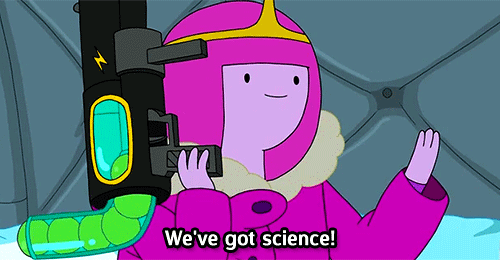Archer: The Comedy of Sound
Note-Another college essay
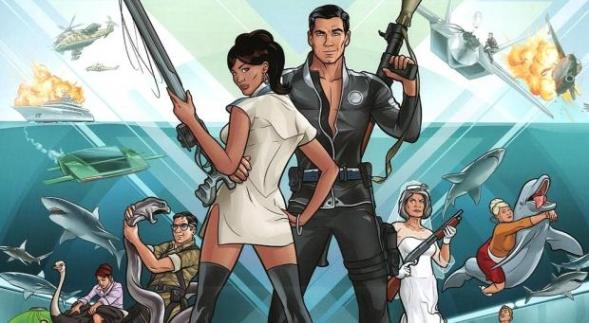
The show Archer, an adult animated spy comedy on FX, is unique in many ways. From the comic book inspired thick outlining to the willingness to break from the standard episodic procedure by having the main cast be drug dealers for a season, Archer is both a parody and a deconstruction of spy films and television shows. This creativity extends to its aesthetic elements as well. In this analysis, I would like to focus specifically on how the show uses the element of dialogue. In particular, I am arguing that the animated comedy Archer uses dialogue in in combination with tools like repetition and miscommunication to enhance both the comedy and narrative of the story in a unique way.
The Dialogue
One of the most evident examples of comedy in sound comes through the dialogue. Ian Dawe makes the claim that, “Archer is clearly a parodic show, and one in the service of comedic ends. One of the strongest elements of the show’s sense of parody comes from its use of, and arguably obsession with, sound”(Dawe, 232). It is this parody aspect of the show that allows it to get away with its outlandish use of dialogue, since it parodies both spy shows and classic cartoon dynamics. The use of catchphrases to reinforce the parody aspects of the show is especially poignant, since in many of the later seasons the characters themselves recognize the catchphrases for what they are. One recurring phrase in Archer is, “Phrasing”, which is used whenever a character says something that could misconstrued as a double entendre. The line is first introduced in episode four of season one and is continually used for the next few seasons until it is quietly phased out around the beginning season four. However, in season five episode ten the title character, Sterling Archer, says, “So, we’re just done with phrasing, right? That’s not a thing anymore?” In fact, for the whole entire season he asks what happened to that particular catchphrase and even attempts to replace it with, “Said Ripley to the android Bishop”. Though a slight detour from catch phrases, I would be remiss if I did not mention another situation in which there was a verbal acknowledgment of the fact that a trope was being parodied. In the seventh episode of season one, Lana and Cyril are having relationships problems that causes them to take a break from the relationship. However, Cyril returns later on help Lana push a bomb off a plane. The conversation that follows is, “I cannot do this alone!” “You’re not alone!” “Baby! you came back to me!” “Lana, we’re not gonna make it!” “Yes, we are, Cyril! We are gonna make it!” “Oh, my god! Lana, we made it!”. This sweet moment is interrupted by Sterling sarcastically exclaiming, “Hurray for metaphors!” The humor comes for Sterling pointing out the cliché to audiences who didn’t notice it and vocalizing the thoughts of the one who did notice the over-exaggeration.
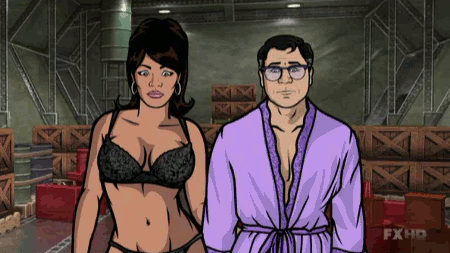
The Catch Phrases
This obsession with catch phrases and the acknowledgment in-show of their power as comedic devices must be noted. Joseph Darlington wrote in his paper “Catchphrases: a semiotic, genealogical and cultural materialist study of the form that, “The first and most essential component of the catchphrase’s signification as regards performers is its role in characterization …a pure metonym for a whole series of social expectations” (Darlington, 125). In this case, the metonym stands for pointing out words and sentences that could be sexual in nature. However, instead of saying “That could be misconstrued as a sexual innuendo and therefore it is funny”, that whole entire sentiment is wrapped up into one nicely packaged word that can be used over and over again without feeling labored. What makes Archer so interesting, however, is it’s complete obsession with catch phrases and reoccurring lines. To just name a few that occur throughout the shows six season run: The head of Human Resources Pam saying “sploosh” whenever somebody says or does something that she finds to be erotic, saying “The danger zone” whenever something exciting or dangerous happens, the secretary Cheryl yelling “You’re not my supervisor” even if it to her superivor, Sterling saying “classic mother” whenever his mom does something morally ambiguous, Sterling saying that he “May literally die” if he might not get something that he desires, Sterling and others saying “Stop…I can only get so erect” when something amazing happens, Sterling yelling Lana’s name multiple times in succession, “Nooope”, and many more. This obsession with running vocal gags makes Archer unique in the sense that everything about it seems over the top and exaggerated. For this show, repetition is king. Joseph Darlington wrote, “In short, repetition is the means by which organisms process and interact with their environment. Enter language, and signification becomes the medium of this interaction. One cannot separate language from its constant repetitions” (Darlington, 127). The show forces the audience to spot patterns, to both encourage familiarity with the content and subvert expectations when the expected response is not delivered in the usual way.
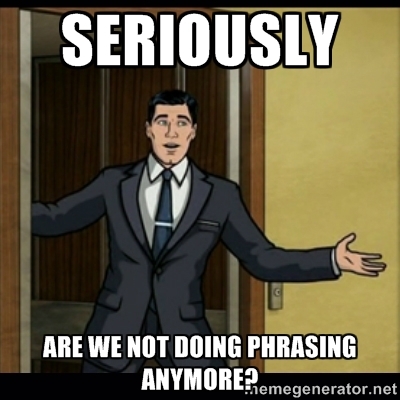
The Sound
Archer’s distinctive style of dialogue is not limited to catchphrases though. One of its most noticeable parodic devices is the use of references. Intertextuality and referencing pop culture is common in television, but the goal is to have the audience laugh because they understand the reference. It makes the audience feel as if they are in on an inside joke. In Archer, however, the joke is that nobody gets the reference. Characters, usually Sterling, make obscure references that do not really exist in the mainstream consciousness. Sometimes the reference is literary, other times it is from a movie, while other times it is a pop culture references from decades ago (which makes sense due to the anachronistic nature of the show). Sterling has either referenced the material of or name-dropped people such as O. Henry, Oscar Wilde, Herman Melville, Emily Post, George Orwell, Manning Coles, Jonathan Edwards, and Rien Poortvlie, the illustrator of Gnomes. This dialogue works comedically on two different levels. The first level is one that reaches the most audiences, the fact that the jock-like and insensitive Sterling Archer is the probably the best-read person in the series, making references that nobody understands. The second, however, is much more selective. The second level is reserved only for the select few who were luck enough to understand what Sterling is referencing and the significance of the reference to the situation. While it is true that in this modern era, one can easily look up the reference on Google or Bing, the time and effort that it would take to do this would rob the moment of its comedic value due to the reliance on timing in comedy. While still adhering to traditional television comedic traditions, Arch also finds a way to parody these conventions by changing how the reference and audience interact. Catchphrases are not the only way in which Archer makes use of dialogue though.
Another example of the use of dialogue for both comedic and narrative is having dialogue continuing on through multiple scenes, either as one conversation between two people or two different conversations that have a sentence that connects them. In the sixth episode of season one, the spy Lana and the CEO of the spy organaizaion ISIS, Malory Archer, are having a conversation about Lana’s current at the time boyfriend, Cyril, and her ex-boyfriend, Sterling. This conversation takes place over four locations: The elevator of the office, the car to the airlines, the airplane, and the taxi outside of the other airport. In this case we see the discourse time much shorter than the story time. While it is understood that the ellipsis suggests that much time is passing, along with the indexical relationship presented by the multiple modes of travel, the actual dialogue flows as one conversation despite the fact that it must either be one long conversation or a collection of conversations. This strange juxtaposition of the dialogic content being presented as scene while the image is presented as ellipsis can be seen as both humorous and useful to providing information while moving the story narrative time along.
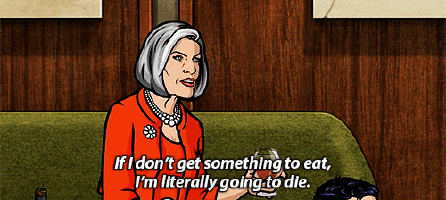
This juxtaposition is also used when transitioning between the kernel and satellites as defined by Seymour Chapman, also known as the A-plot and B-plot or main plot and subplot. This is done by either taking advantage of a word having multiple meanings or simply having a sentence working in both scenes. In the eighth episode of season one, the former is used. When talking about earning a contract to Sterling and Lana, Mallory Archer says, “All of San Marino could fit in the South Bronx. The Important thing is that they’re loaded”. This is followed immediately followed by Pam talking to Cyril saying “About 15 freakin’ beers, all that schuetzie, and holy shit! Did I honk down a bunch of absinthe?”. This is a transition from the kernel that is about ISIS trying to earn a contract and Pam and Cyril talking about the party they went to last night. Once again, we see an eclipse. The physical scene changes with a cut. However, the two are connected with a word. In this case the word is loaded, which in colloquial terms means that someone or something is excessively rich but can also mean that somebody had an excessive amount of alcohol. This is not a one time device and can be seen being used multiple times in one episode.
Later on in the same episode, the latter example of having a sentence that has the same meaning but in two different sentences is used. In fact, this is done between the second scene of the previous example and a new scene. After Cyril punched Pam in the stomach he apologizes by saying, “ Wow, I am incredibly sorry”. The story then cuts back the scene with Mallory, Sterling, and Lana in the conference room. Time has obviously passed, since the leader of San Marino is talking to them via a video screen and says, “ …but that is my decision Ms. Archer, and as captain regent as…” The whole entire sentence “ I am incredibly sorry” is being used to connect the two scenes. Ian Dawe refers to this as bridging. He goes onto write:
This technique, once again rarely seen in animation, not only creates more jokes but blends the episodes together in a creative way that highlights the centrality of sound in their construction. Non-verbal sound, or any other kind of sound, seems to form the basis of the communication between all of the characters in Archer (Dawe, 235).
Every television show uses particular techniques in dialogue to suite their specific needs. What’s so unique about Archer is the way that dialogue functions as both a comedic and narrative tool. In many cases, the dialogue functions in the same as way as a camera fade or cut by bringing two scenes together. While much of Archer is reliant on communication, miscommunication also plays an important role in dialogue.

For Archer, comedy through dialogue relies both on how well characters interact verbally, but also how badly they interact. In the seventh episode of season one, Lana and Sterling have to disable a bomb. In order to find out what wire to cut, they must contact headquarters and talk with a fellow agent, Ray, telling him the serial number on the bomb. The complication with this procedure is multi-pronged, and all come from errors in communication. The first is the fact that the satellite link becomes fuzzy, muffling Sterlings words on certain letters. The second is that Sterling does not know the NATO phonetic alphabet, forcing Lana to take over. The third is when Sterling uses the word okay and it is misinterpreted as the letters ‘O’ and ‘K’, since Sterling used okay instead of ‘Roger’. The linguistic nightmare ends when Sterling tells Ray the last two letters of the code. The twist is that the last word that Sterling used was muffled. While everyone thought Sterling said “N as in Nancy”, he said “M as an Mancy”, causing the timer to pick up speed. The sequence takes about three and half minutes, a significant amount of time for a twenty-two minute episode. Another example of miscommunication is actually another example of a running gag. Sterling has habit of firing his gun right by his ear, resulting in temporary hearing loss. Archer uses a high-pitched tone to simulate tinnitus. Just like Sterling, the viewer can only hear what Sterling is saying, with all of the dialogue drowned out. This causes Sterling to misunderstand what is being said around him. These are only two examples of miscommunication being used for comedy in Archer. The comedy works because it subverts our expectations as viewers. Yet another running gag is Sterling’s long and confusing voicemail that tricks the caller into thinking that they are actually talking to him. Each successive voicemail gets more complex, attempting to fool the viewer along with the character calling him. As viewers, we are used to being omniscient their-person viewers with the power of dramatic irony on our side. When Archer takes that power away from us, we are forced to react in real time with the characters and experience what they experience, which is usually confusion.
Dialogue in comedic television shows tend to fairly formulaic. Sometimes it succeeds, as in Friends. Other times the formula fails, such as The McCarthys. In most cases though, changing the formula is a risk that most companies would not want to take. Archer, however, refuses to be trapped. It switches back and forth between conventional and unconventional dialogue to create a unique blend that sets it apart from other television shows. With both repetition and miscommunication as its tools, Archer may not be reinventing comedy, but it certainly is livening it up.
-Grant
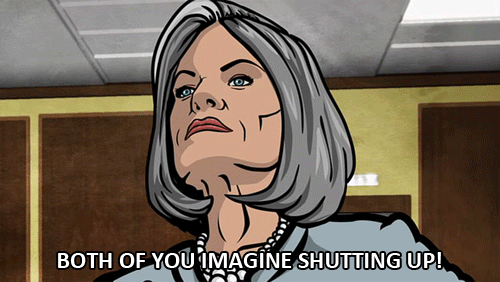
Works Cited
Darlington, Joseph. “Catchphrases: A Semiotic, Genealogical and Cultural Materialist Study of the Form.” Comedy Studies 5.2 (2014): 123-36. EbscoHost. Web. 26 Oct. 2015.
Dawe, Ian. “Archer: A Spy Parody for Ears.” James Bond and Popular Culture: Essays on the Influence of the Fictional Superspy. By Michele Brittany. Jeferson: McFarland, 2014. 232+. Print.


